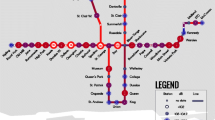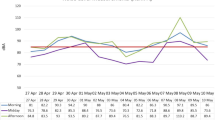Abstract
Excessive noise exposure is a serious global urban health problem, adversely affecting millions of people. One often cited source of urban noise is mass transit, particularly subway systems. As a first step in determining risk within this context, we recently conducted an environmental survey of noise levels of the New York City transit system. Over 90 noise measurements were made using a sound level meter. Average and maximum noise levels were measured on subway platforms, and maximum levels were measured inside subway cars and at several bus stops for comparison purposes. The average noise level measured on the subway platforms was 86 ± 4 dBA (decibel-A weighting). Maximum levels of 106, 112, and 89 dBA were measured on subway platforms, inside subway cars, and at bus stops, respectively. These results indicate that noise levels in subway and bus stop environments have the potential to exceed recommended exposure guidelines from the World Health Organization (WHO) and U.S. Environmental Protection Agency (EPA), given sufficient exposure duration. Risk reduction strategies following the standard hierarchy of control measures should be applied, where feasible, to reduce subway noise exposure.
Similar content being viewed by others
References
The MTA Network. Metropolitan Transit Authority. Available at: http://www.mta.nyc.ny.us/mta/network.htm. Accessed April 4, 2006.
A World of Trams and Urban Transit. LRTA. Available at: http://www.lrta.org/world/worldind.html. Accessed April 4, 2006.
U.S. Department of Transportation, Bureau of Transportation Statistics. National Transportation Statistics 2003. Fuel Consumption by Mode of Transportation, Washington, District of Columbia. Available at: http://www.bts.gov/publications/national_transportation_statistics/2003/html/table_04_05.html. Accessed April 4, 2006.
Seshagiri B. Exposure to noise on board locomotives. AIHAJ. 2003;64:699–707.
Gershon RRM, Qureshi KA, Barrera MA, et al. Health and safety hazards associated with subways: a review. J Urban Health. 2005;82(1):10–20.
Johanning F, Fischer S, Christ E, Gores B, Landsbergis P. Whole-body vibration exposure study in U.S. railroad locomotives: an ergonomic risk assessment. AIHAJ. 2002;63:439–446.
Guidotti TL, Cottle MKW. Occupational health problems among transit workers. Public Health Rev. 1987;15:29–44.
Chillrud SN, Epstein D, Ross JM, et al. Elevated airborne exposures of teenagers to manganese, chromium, and iron from steel dust and New York City's subway system. Environ Sci Technol. 2004;38:732–737.
Yu IJ, Yoo CY, Chung YH, et al. Asbestos exposure among Seoul metropolitan subway workers during renovation of subway air-conditioning systems. Environ Int. 2004;29:931–934.
Krause N, Ragland DR, Fisher JM, Shyme SL. Volvo award winner in clinical studies: psychosocial job factors, physical workload, and incidence of work-related spinal injury: a 5-year prospective study of urban transit workers. Spine. 1998;23:2507–2517.
Boudia N, Halley R, Kennedy G, Gareau L, Zayed J. Manganese concentrations in the air of the Montreal (Canada) subway in relation to surface automobile traffic density. Toxicologist. 2004;78(S-1):80.
Dietrich FM, Jacobs WL. Survey and assessment of Electric Magnetic Field (EMF) Public Exposure in the Transportation Environment. U.S. Department of Transportation, Federal Railroad Administration; 1999. Report No. PB99-130908.
Muc AM. Electromagnetic fields associated with transportation systems. Available at: http://www.rhsc.ca/TransEMF.pdf. Accessed April 4, 2006.
Nelson DI, Nelson RY, Concha-Barrientos M, et al. The global burden of occupational noise-induced hearing loss. Am J Ind Med. 2005;48:446–458.
Garcia A. Introduction. In: Garcia A, ed. Environmental Urban Noise. Southampton, UK: WIT; 2001:1–13.
Smith A. The fifteenth most serious health problem in the WHO perspective. Presentation to IFHOH World Congress, Helsinki, July 2004. Available at: http://www.kuulonhuoltoliitto.fi/tiedoston_katsominen.php?dok_id=150. Accessed April 4, 2006.
Simpson M, Bruce R. Noise in America: The extent of the noise problem. U.S. Environmental Protection Agency, EPA Report No. 550/9-81-101, 1981.
U.S. Department of Labor, Occupational Safety and Health Administration (OSHA). 2002. Noise and Hearing Conservation. Available at: http://www.osha-slc.gov/SLTC/noisehearingconservation/index.html. Accessed on April 4, 2006.
World Health Organization (WHO). 2004. Occupational noise: assessing the burden of disease from work- related hearing impairment at national and local levels. Environmental Burden of Disease Series, Number 9. Geneva.
Axelson, A. Recreational exposure to noise and its effects. Noise Control Eng J. 1996;44:127–134.
Neitzel R, Seixas N, Goldman B, Daniell W. Contributions of non-occupational activities to total noise exposure of construction workers. Ann Occup Hyg. 2004;48(5):463–473.
Davis AC, Fortnum HM, Coles RRA, Haggard MP, Lutman ME. et al. Damage to Hearing arising from Leisure Noise: A Review of the Literature. MRC Institute of Hearing Research. Nottingham, England: University of Nottingham, 1985.
Kryter KD. Hearing loss from gun and railroad noise—relations with ISO standard 1999. J Acoust Soc Am. 1991;90(6):180–195.
Starck J, Toppila E, Pyykko I. Impulse noise and risk criteria. Noise Health. 2003;5(20):63–73.
Vallet M. Effects of noise on health. In: Garcia A, ed. Environmental Urban Noise. Southampton, UK: WIT; 2001:63–109.
Davis R, Hamernik R. Noise and hearing impairment. In: Levy BS, Wegman DH, eds. Occupational Health: Recognizing and Preventing Work-Related Disease. 3rd ed. Boston: Little Brown; 1995:321–336.
Talbott EO, Gibson LB, Burks A, Engberg A, McHugh KP. Evidence for a dose-response relationship between occupational noise and blood pressure. Arch Environ Health. 1999;54(2):7178.
Lusk SL, Hagerty BM, Gillespie B, Caruso CC. Chronic effects of workplace noise on blood pressure and heart rate. Arch Environ Health. 2002;57:273–281.
Hetu R, Getty L, Quoc HT. Impact of occupational hearing loss on the lives of workers. Occup Med State Art Rev. 1995;10:495–512.
Melamed S, Luz J, Green MS. Noise exposure, noise annoyance and their relation to psychological distress, accident and sickness among blue collar workers–the Cordis Study. Israel J Med Sci. 1992;28:629–635.
Miller JD. Effects of noise on people. J Acoust Soc Am. 1974;53(3):729–764.
Barrett D. Urban Soundscapes: What should a public space sound like? Available at: http://www.hmmh.com/presentations/urban_soundscape-deb.pdf. Accessed April 4, 2006.
U.S. Department of Health and Human Services. Healthy People 2010: Understanding and Improving Health. 2nd ed. Washington, District of Columbia: U.S. Government Printing Office; 2000.
U.S. Occupational Safety and Health Administration (OSHA). Occupational Noise Exposure: Hearing Conservation Amendment; Final Rule. Fed Reg Washington, District of Columbia: U.S. Department of Labor, Occupational Safety and Health Administration. 1983:9738–9785.
U.S. National Institute for Occupational Safety and Health (NIOSH). Criteria for a recommended standard: Occupational noise exposure revised criteria 1998. Cincinnati, OH: Department of Health and Human Services, Public Health Service, Centers for Disease Control and Prevention, National Institute for Occupational Safety and Health, DHHS (NIOSH) Publication No. 98–126; 1998.
U.S. Environmental Protection Agency (EPA). Protective noise levels: condensed version of EPA levels document. EPA Report No. 550/9-79-100. Washington, District of Columbia, U.S., 1979.
World Health Organization (WHO). In: Berglund B, Lindvall T, Schwela D, eds. Guidelines for Community Noise. Geneva: World Health Organization; 1999.
Passchier-Vermeer W, Passchier WF. Noise exposure and public health. Environ Health Perspect. 2000;108 (Suppl 1):123–31.
Gassaway D. Noise-induced hearing loss. In: McCunney R, ed. ccA Practical Approach to Occupational and Environmental Medicine. 7th ed. Boston: Little Brown; 1994:230–247.
Harris CM, Aitken BH. Noise in subway cars. Sound Vibration. 1971; February issue:21–24.
Stanton GT. Noise survey of rapid transit lines for the Board of Transportation of the City of New York, NYC. June 20, 1931.
May J. Occupational hearing loss. Am J Indust Med. 2000;37:112–120.
U.S. Environmental Protection Agency (EPA). Information on levels of environmental noise requisite to protect public health and welfare with an adequate margin of safety. EPA Report 550/9-74-004, Washington, District of Columbia, U.S.; 1974.
Abbate C, Concetto G, Fortunato M, et al. Influence of environmental factors on the evolution of industrial noise-induced hearing loss. Environ Monitoring Assess. 2005;107:351-361.
U.S. Environmental Protection Agency (EPA). Passenger noise environments of enclosed transportation systems. EPA Report Number 550/9-75-205. Environmental Protection Agency, Office of Noise Abatement and Control. Washington, District of Columbia; 1975.
Cohen A, Anticaglia J, Jones H. Sociocusis: hearing loss from non-occupational noise exposure. Sound Vibration. 1970;4:12–20.
Johanning E, Wilder DG, Landrigan PJ, Pope MH. Whole-body vibration exposure in subway cars and review of adverse health effects. J Occup Med. 1991;33:605–612.
Chang HC, Hermann ER. Acoustical study of a rapid transit system. Amer Ind Hyg Assoc J. 1974;35:640–653.
Manning CJ, Harris GJ. Noise control in transportation. Noise Health. 2003;5(18):43–45.
Garcia A. Urban noise control. In: Garcia A, ed. Environmental Urban Noise. Southampton, UK; WIT; 2001:183–225.
Wolfe SL. Introduction to train noise. In: Nelson P, ed. Transportation Noise Reference Book. Butterworths, London; 1986:13/1–13/6.
Remington PJ, Kurzweil LG, Towers DA. Practical examples of train noise and vibration control. In: Nelson P, ed. Transportation Noise Reference Book. Butterworths, London; 1986:17/1–17/23.
Berger EH. Chapter 10: Hearing protection devices. In: Berger EH, Royster LH, Royster JD, Driscoll DP, Layne ML, eds. The Noise Manual. 5th ed. U.S.: American Industrial Hygiene Association. Fairfax, VA; 2000:379–454.
Author information
Authors and Affiliations
Corresponding author
Additional information
Gershon and Barrera are with the Department of Sociomedical Sciences, Columbia University, Mailman School of Public Health, 600 West 168th Street, 4th Floor, New York, NY 10032, USA; Neitzel is with the Department of Environmental and Occupational Health Sciences, University of Washington, Seattle, WA 98105, USA; Akram is with the Department of Environmental Health Sciences, Columbia University, Mailman School of Public Health, New York, NY 10032, USA.
Rights and permissions
About this article
Cite this article
Gershon, R.R.M., Neitzel, R., Barrera, M.A. et al. Pilot Survey of Subway and Bus Stop Noise Levels. JURH 83, 802–812 (2006). https://doi.org/10.1007/s11524-006-9080-3
Published:
Issue Date:
DOI: https://doi.org/10.1007/s11524-006-9080-3




